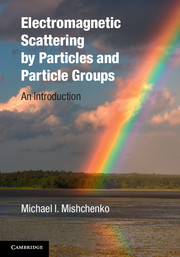Book contents
- Frontmatter
- Dedication
- Contents
- Preface
- Acknowledgments
- Acronyms
- 1 Introduction
- 2 The macroscopic Maxwell equations and monochromatic fields
- 3 Fundamental homogeneous-medium solutions of the macroscopic Maxwell equations
- 4 Basic theory of frequency-domain electromagnetic scattering by a fixed finite object
- 5 Far-field scattering
- 6 The Foldy equations
- 7 The Stokes parameters
- 8 Poynting–Stokes tensor
- 9 Polychromatic electromagnetic fields
- 10 Polychromatic scattering by fixed and randomly changing objects
- 11 Measurement of electromagnetic energy flow
- 12 Measurement of the Stokes parameters
- 13 Description of far-field scattering in terms of actual optical observables
- 14 Electromagnetic scattering by a small random group of sparsely distributed particles
- 15 Statistically isotropic and mirror-symmetric random particles
- 16 Numerical computations and laboratory measurements of electromagnetic scattering
- 17 Far-field observables: qualitative and quantitative traits
- 18 Electromagnetic scattering by discrete random media: far field
- 19 Near-field scattering by a sparse discrete random medium: microphysical radiative transfer theory
- 20 Radiative transfer in plane-parallel particulate media
- 21 Weak localization
- 22 Epilogue
- Appendix A Dyads and dyadics
- Appendix B Free-space dyadic Green's function
- Appendix C Euler rotation angles
- Appendix D Spherical-wave decomposition of a plane wave in the far zone
- Appendix E Integration quadrature formulas
- Appendix F Wigner d-functions
- Appendix G Stationary phase evaluation of a double integral
- Appendix H Hints and answers to selected problems
- References
- Index
- Plate Section
4 - Basic theory of frequency-domain electromagnetic scattering by a fixed finite object
Published online by Cambridge University Press: 05 July 2014
- Frontmatter
- Dedication
- Contents
- Preface
- Acknowledgments
- Acronyms
- 1 Introduction
- 2 The macroscopic Maxwell equations and monochromatic fields
- 3 Fundamental homogeneous-medium solutions of the macroscopic Maxwell equations
- 4 Basic theory of frequency-domain electromagnetic scattering by a fixed finite object
- 5 Far-field scattering
- 6 The Foldy equations
- 7 The Stokes parameters
- 8 Poynting–Stokes tensor
- 9 Polychromatic electromagnetic fields
- 10 Polychromatic scattering by fixed and randomly changing objects
- 11 Measurement of electromagnetic energy flow
- 12 Measurement of the Stokes parameters
- 13 Description of far-field scattering in terms of actual optical observables
- 14 Electromagnetic scattering by a small random group of sparsely distributed particles
- 15 Statistically isotropic and mirror-symmetric random particles
- 16 Numerical computations and laboratory measurements of electromagnetic scattering
- 17 Far-field observables: qualitative and quantitative traits
- 18 Electromagnetic scattering by discrete random media: far field
- 19 Near-field scattering by a sparse discrete random medium: microphysical radiative transfer theory
- 20 Radiative transfer in plane-parallel particulate media
- 21 Weak localization
- 22 Epilogue
- Appendix A Dyads and dyadics
- Appendix B Free-space dyadic Green's function
- Appendix C Euler rotation angles
- Appendix D Spherical-wave decomposition of a plane wave in the far zone
- Appendix E Integration quadrature formulas
- Appendix F Wigner d-functions
- Appendix G Stationary phase evaluation of a double integral
- Appendix H Hints and answers to selected problems
- References
- Index
- Plate Section
Summary
As we have discussed in Chapter 1, the presence of an object with a refractive index different from that of the surrounding host medium changes the electromagnetic field that would otherwise exist in an unbounded homogeneous space. The difference between the total field in the presence of the object and the total field that would exist in the absence of the object can be thought of as the field scattered by the object. In other words, the total electromagnetic field in the presence of the object is mathematically represented as the vector sum of the incident and scattered fields.
The spatial distribution of the scattered field depends on specific characteristics of the incident field as well as on such properties of the scatterer as its size relative to the wavelength and its morphology, composition, and orientation. Therefore, in practice one usually must solve the scattering problem anew every time some or all of these input parameters change. It is appropriate, however, to consider first the general mathematical description of electromagnetic scattering without making any detailed assumptions about the scattering object, except that it is composed of linear, isotropic, and nonmagnetic materials. Hence the goal of this chapter is to establish a basic theoretical framework underlying specific problems discussed in the following chapters. Consistent with this objective and with the discussion in Section 1.1, we will assume that the scattering object is stationary and will consider only monochromatic fields whose dependence on time is completely described by the time-harmonic factor exp(—iωt).
- Type
- Chapter
- Information
- Electromagnetic Scattering by Particles and Particle GroupsAn Introduction, pp. 41 - 49Publisher: Cambridge University PressPrint publication year: 2014



